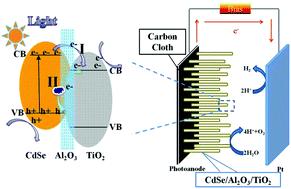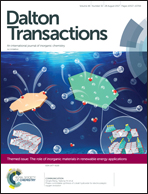Promoted photoelectrocatalytic hydrogen evolution of a type II structure via an Al2O3 recombination barrier layer deposited using atomic layer deposition†
Abstract
Constructing a semiconductor type II structure is an effective way to enhance the photogenerated charge separation efficiency. The separation and migration of interfacial photogenerated carriers is a key factor, which influences the photocatalytic activity. In this study, a conformal Al2O3 recombination barrier layer was introduced at the interface between TiO2 nanowires and CdSe nanoparticles, and the application of this composite in photoelectrocatalytic (PEC) hydrogen production was explored. Under visible-light irradiation, the photocurrent response and PEC hydrogen evolution performance increased step-by-step from TiO2 to the Al2O3/TiO2 and CdSe/Al2O3/TiO2 nanowire arrays. Moreover, the H2 evolution rate of CdSe/Al2O3/TiO2 was much higher than that of a different configuration, Al2O3/CdSe/TiO2. The enhanced PEC hydrogen evolution performance was attributed to the prevention of the interfacial charge recombination caused by the Al2O3 recombination barrier layer. Our results may shed new light on developing novel and highly efficient photocatalysts using rational interface design.

- This article is part of the themed collection: The Role of Inorganic Materials in Renewable Energy Applications


 Please wait while we load your content...
Please wait while we load your content...